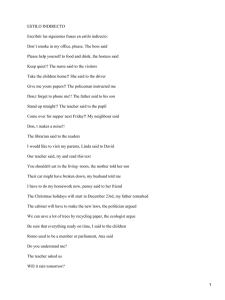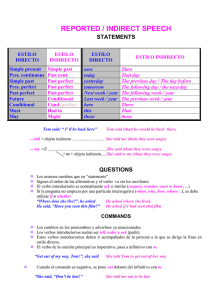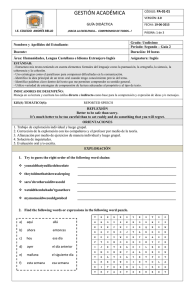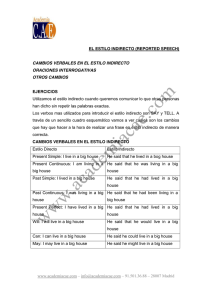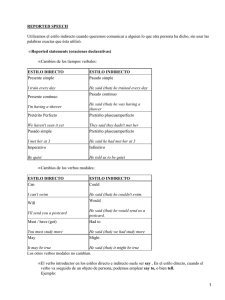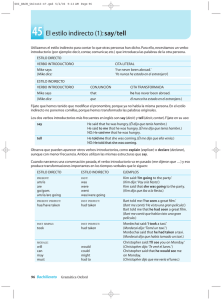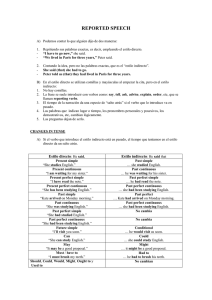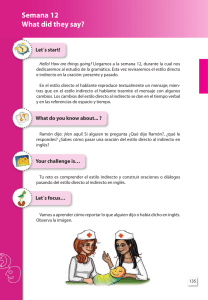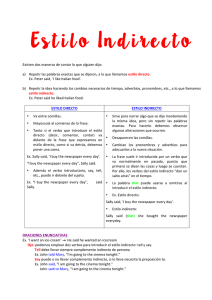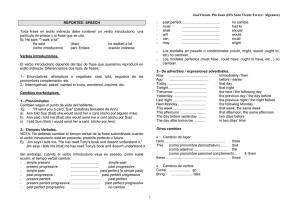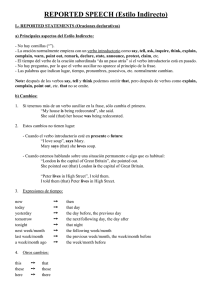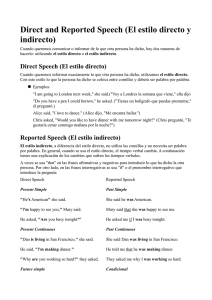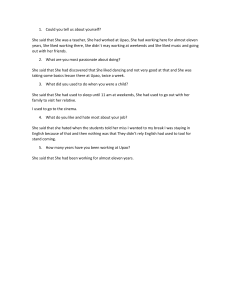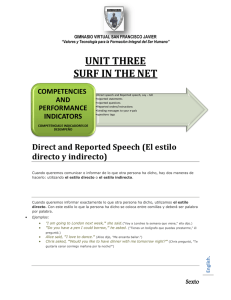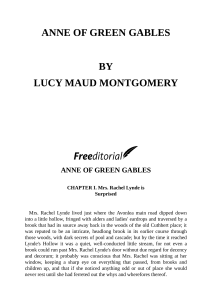Reported Speech - yoquieroaprobar.es
Anuncio
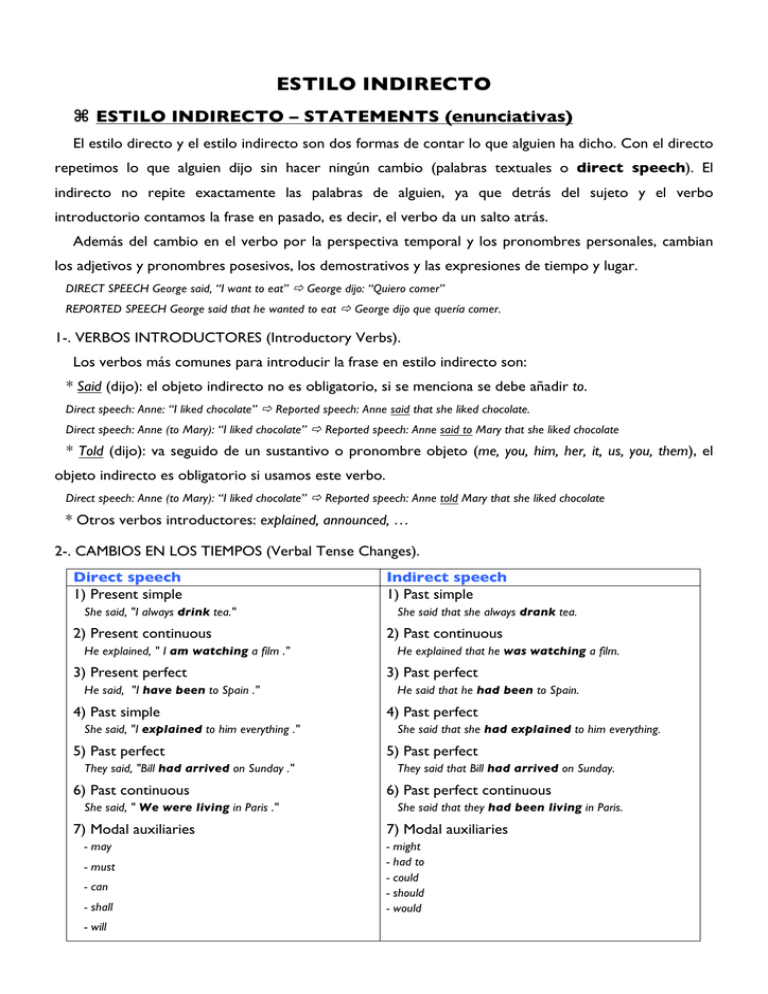
ESTILO INDIRECTO ⌘ ESTILO INDIRECTO – STATEMENTS (enunciativas) El estilo directo y el estilo indirecto son dos formas de contar lo que alguien ha dicho. Con el directo repetimos lo que alguien dijo sin hacer ningún cambio (palabras textuales o direct speech). El indirecto no repite exactamente las palabras de alguien, ya que detrás del sujeto y el verbo introductorio contamos la frase en pasado, es decir, el verbo da un salto atrás. Además del cambio en el verbo por la perspectiva temporal y los pronombres personales, cambian los adjetivos y pronombres posesivos, los demostrativos y las expresiones de tiempo y lugar. DIRECT SPEECH George said, “I want to eat” ð George dijo: “Quiero comer” REPORTED SPEECH George said that he wanted to eat ð George dijo que quería comer. 1-. VERBOS INTRODUCTORES (Introductory Verbs). Los verbos más comunes para introducir la frase en estilo indirecto son: * Said (dijo): el objeto indirecto no es obligatorio, si se menciona se debe añadir to. Direct speech: Anne: “I liked chocolate” ð Reported speech: Anne said that she liked chocolate. Direct speech: Anne (to Mary): “I liked chocolate” ð Reported speech: Anne said to Mary that she liked chocolate * Told (dijo): va seguido de un sustantivo o pronombre objeto (me, you, him, her, it, us, you, them), el objeto indirecto es obligatorio si usamos este verbo. Direct speech: Anne (to Mary): “I liked chocolate” ð Reported speech: Anne told Mary that she liked chocolate * Otros verbos introductores: explained, announced, … 2-. CAMBIOS EN LOS TIEMPOS (Verbal Tense Changes). Direct speech 1) Present simple She said, "I always drink tea." 2) Present continuous He explained, " I am watching a film ." 3) Present perfect He said, "I have been to Spain ." 4) Past simple She said, "I explained to him everything ." 5) Past perfect They said, "Bill had arrived on Sunday ." 6) Past continuous She said, " We were living in Paris ." 7) Modal auxiliaries - may - must - can - shall - will Indirect speech 1) Past simple She said that she always drank tea. 2) Past continuous He explained that he was watching a film. 3) Past perfect He said that he had been to Spain. 4) Past perfect She said that she had explained to him everything. 5) Past perfect They said that Bill had arrived on Sunday. 6) Past perfect continuous She said that they had been living in Paris. 7) Modal auxiliaries - might - had to - could - should - would 3-. CAMBIOS EN PRONOMBRES PERSONALES Y POSESIVOS. Direct speech I me mine my… this these Indirect speech he / she him / her his / hers his / her… that those 3-. CAMBIOS EN EXPRESIONES DE TIEMPO, LUGAR Y DEMOSTRATIVOS. Direct speech 1) today 2) yesterday 3) tomorrow 4) the day after tomorrow 5) next week ,year ,month… 6) last week ,year , month… 7) A week , year, month….ago 8) now 9) here Indirect speech 1) that day 2) the day before / the previous day 3) the next day / the following day 4) in two days time 5) the following week, year ,month…. 6) the previous week , year , month…. 7) A year, week, month ….before 8) then / at that moment 9) there ⌘ ESTILO INDIRECTO – QUESTIONS (preguntas) Al pasar una pregunta a estilo indirecto es importante saber que deja de serlo y se convierte en una oración enunciativa, por tanto ya no hay inversión sujeto-verbo, ni verbo auxiliar, ni signo de interrogación. Los cambios en los tiempos verbales, pronombres, expresiones de tiempo y lugar se mantienen. El principal verbo introductor es asked (preguntó). 1-. YES / NO QUESTIONS (preguntas que se contestan con sí o no) Se utiliza if /whether después de asked. “Do you like chocolate?” Tom asked ð Tom asked if / whether I liked chocolate. 2-. WH- QUESTIONS (preguntas que empiezan con partículas interrogativas what, when,...) Mantienen la partícula al principio, seguida del sujeto y el verbo. “What is your favourite film?” she asked ð Anne asked what my favourite film was. ⌘ ESTILO INDIRECTO – COMMANDS or REQUESTS (imperativas) 1-. POSITIVE COMMAND She said, " Put your jacket on the table" ð She ordered him to put his jacket on the table . 1-. NEGATIVE COMMAND He had ordered him, "Don't leave the room “ ð He had ordered him not to leave the room . The present tense may be used in the reported speech, when the sentence expresses: 1) General facts: The teacher said," The earth is round" ð The teacher said that the earth is round . 2) Habitual facts: He said," We get up early every morning" ð He said that they get up early every morning.
